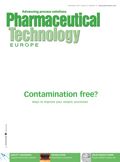Innovations in aseptic technology
Pharmaceutical Technology Europe
Closed vial technology has been designed to address the challenges - potential contamination, counterfeiting and process complexity - associated with the aseptic filling of injectable drugs.
Closed vial technology has been designed to address the challenges — potential contamination, counterfeiting and process complexity — associated with the aseptic filling of injectable drugs. Essentially, a vial is provided stoppered, cleaned inside and gamma-sterilized, therefore ready-to-fill. The filling is done by a needle piercing the stopper and dispensing the liquid, then the puncture trace is immediately laser-resealed and capped; all operations are done in a Class ISO 5 environment.

(George Doyle/Getty Images)
Key advantages
Closed vial technology has major advantages compared with usual technologies using the glass vial:
Better sterility assurance level and reduced particle presence
The most important advantage is an increase in product quality for the patient. This quality increase is observed for both sterility assurance level and particle presence. The higher sterility assurance level is obtained through the concept of keeping the vial always closed, therefore, reducing the risk of a contaminant penetrating the container. The cap design ensures the entire stopper surface is protected by a circular rib located on the inner face of the cap. This creates additional closure integrity to prevent contamination of the external stopper surface.
Simplified filling operations
Closed vial technology simplifies the filling operation. Several glass filling equipment become obsolete with the closed vial technology:
- No washing
- No need of water for injection on the filling line
- No sterilization
- No stoppering station
- No crimping station using aluminium caps.
Secured supply chain, environmentally-friendly and easier handling
The vial design improves supply chain security until the product is injected into the patient.
• The vial body is made of plastic, such as cyclo-olefin copolymer (COC) (Crystal; Aseptic Technologies, Belgium), which is resistant to shocks and is difficult to break. It avoids vial breakage during filling, storage, transportation and handling by healthcare practitioners. COC is much more expensive than glass and the molding process in a clean environment is also more expensive than producing 'dirty' glass. Nevertheless, many clients have shown that the more expensive price for the vial is eliminated by the reduced manufacturing costs, particularly when the products themselves are expensive. Furthermore, clients have found that the additional manufacturing costs are far below the additional gross profit that can be achieved thanks to a better perception by end-users leading to a few percent more sales. We sponsored research comparing the Crystal closed vial technology with the classical glass vial for injectable products. This research has been conducted by a university according to ISO standard. The outcome is that Crystal scores better on all categories of environmental impact by at least 20%. In fact, vial filling using Crystal technology was found to reduce environmental impact by 93%, when compared with glass vial technology (Figure 1).

Figure 1
• Anticounterfeiting technologies such as secured RFID placement online or online laser coding can be incorporated.
• Handling, opening, piercing and liquid collection is easier compared with glass vials.
The future?
As discussed, closed vial technology has several clear advantages compared with glass vial technology. In particular, I believe that the materials we use to manufacture these vials are of utmost importance to this technology's success. Crystal technology, although more expensive than glass, has been found to be more cost-effective overall by existing users, because of the reduced manufacturing costs associated with its use. As a result, I believe Crystal technology will become a standard once a first product is approved (stability studies ongoing at GSK Bio), especially for potent products (e.g., cytotoxics), biohazard products (e.g., recombinant viruses), expensive drugs (e.g., biologicals) and frozen products (e.g., cell therapies).

Spray drying
Changing from glass to Crystal requires new stability studies. The best opportunities for using the Crystal technology are for new drugs; for new facilities (strong reduction of investment allowing stability programmes); and to replace glass facilities with issues leading to batch rejection.

Pharmaceutical Tariffs Are Imminent: How Industry is Bracing for Impact
April 16th 2025On April 14, 2025, the Trump Administration launched a national security-driven investigation into pharmaceuticals, a move that will likely result in tariffs being placed on pharmaceutical drugs, ingredients, and other components that are imported from outside of the United States.
Drug Solutions Podcast: A Closer Look at mRNA in Oncology and Vaccines
April 30th 2024In this episode fo the Drug Solutions Podcast, etherna’s vice-president of Technology and Innovation, Stefaan De Koker, discusses the merits and challenges of using mRNA as the foundation for therapeutics in oncology as well as for vaccines.